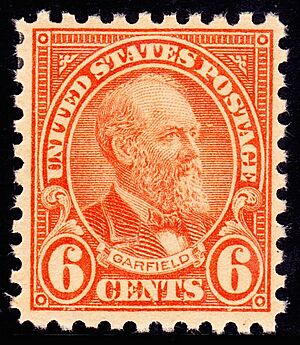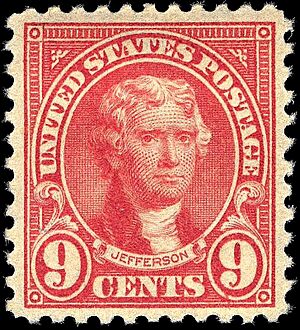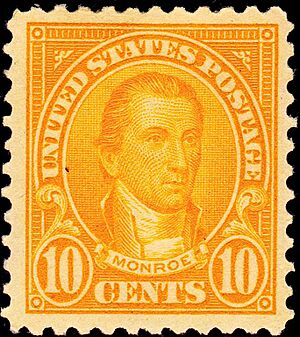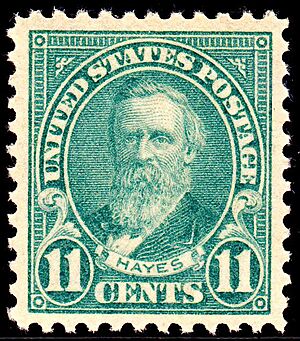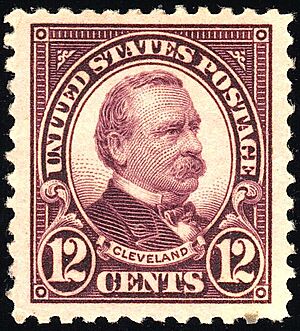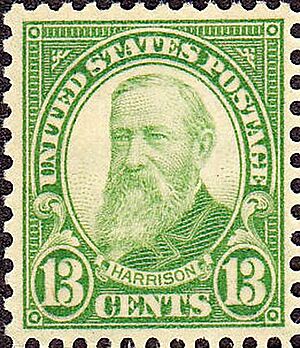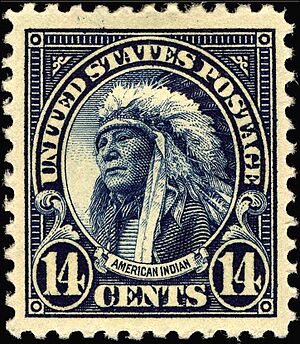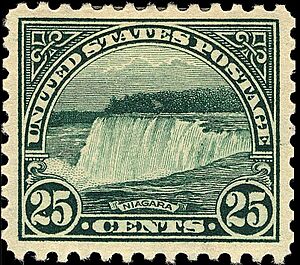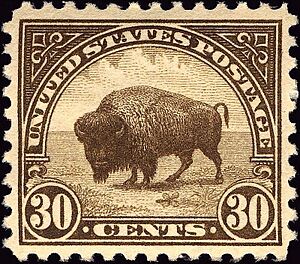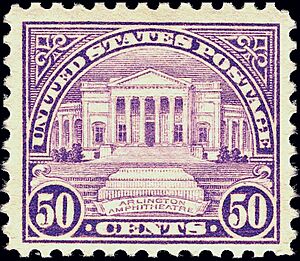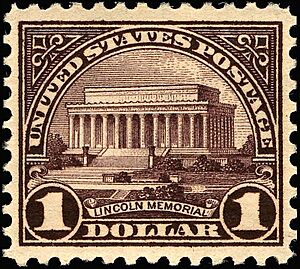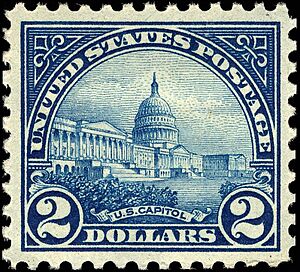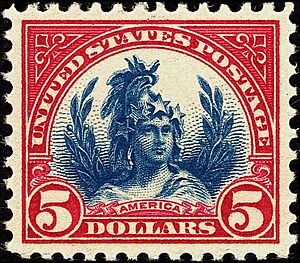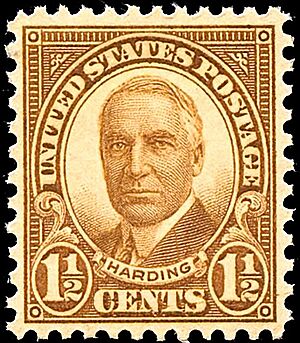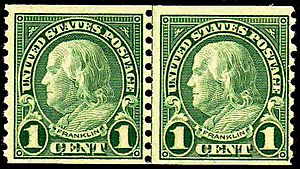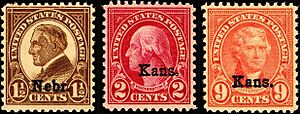US Regular Issues of 1922–1931 facts for kids
The Regular Issues of 1922–1931 were a special collection of 27 postage stamps used every day in the U.S. These stamps were different from older ones because they showed many different presidents and other important people, not just George Washington or Benjamin Franklin. This series brought back the tradition of honoring many leaders on stamps.
It featured famous presidents like Abraham Lincoln, Ulysses S. Grant, George Washington, and Thomas Jefferson. It also honored more recent presidents like Rutherford B. Hayes, William McKinley, Grover Cleveland, and Theodore Roosevelt. Later, stamps were added for Warren G. Harding, Woodrow Wilson, and William Howard Taft. Benjamin Harrison also got a stamp, even though he had been honored before.
This collection also included other important Americans, like Martha Washington and Nathan Hale. Plus, it was the first time since 1869 that U.S. stamps showed famous American scenes, not just portraits. These scenes included the Statue of Liberty, the Capitol Building, and even an American Buffalo. People didn't like the scenes on stamps in 1869, but they loved them on these 1922 stamps! The scenes were mostly on the stamps with higher values, while the common stamps still had portraits.
The Bureau of Engraving and Printing in Washington D.C. made these stamps. This series was the first to have stamps with half-cent values. It also featured the first stamp honoring the Statue of Liberty and the first stamps for presidents Warren G. Harding, Rutherford B. Hayes, Grover Cleveland, Theodore Roosevelt, Woodrow Wilson, and William Howard Taft.
At first, these stamps were printed one sheet at a time using a "flat-plate" press. But soon, they started using a "rotary press," which printed much faster from long rolls of paper. Stamps from the rotary press looked a little less clear. These stamps were released over nine years and can be found with three different sizes of tiny holes (called perforations) around their edges. These perforations help collectors identify which series a stamp belongs to.
What Made These Stamps Special?
The stamps from 1922, also called the Fourth Bureau Issue by collectors, came in values from ½-cent to 5-dollars. Each stamp had a different subject and color. This was only the second time the U.S. Post Office printed the name of the person or place on the stamp itself. Before, on the Washington–Franklin Issues, you only saw the picture.
Many of the stamps from 1-cent to 15-cents used colors that were the same or very similar to the older stamps. New colors were chosen for the 1½-cent and 14-cent stamps because these values were new.
The very first stamp in this series was the 11-cent Rutherford B. Hayes stamp, released on October 4, 1922. This date was also Hayes's 100th birthday! This stamp was first sold in Hayes's hometown of Fremont, Ohio, and in Washington D.C. This started the tradition of releasing new stamps on a specific day and in a special city. Many collectors see the Hayes stamp as the start of modern "First Day Cover" collecting.
Benjamin Franklin and George Washington were usually on the most common stamps (1-cent and 2-cent) used for postcards and first-class letters. A cool design feature of this series is that stamps valued at 17 cents and higher were printed sideways (landscape format). This made them easy to tell apart from the cheaper stamps (15 cents and lower), which were printed upright (portrait format).
These stamps were made in three main ways: as single sheets, as "coil stamps" (long rolls of stamps), and as "booklet stamps" (small booklets of six stamps). There were three main printings, or series, released over about two years each. The 26 different subjects were used to print over 75 different stamps across these three series over ten years.
How Were They Made?
Unlike previous stamp collections, this series was the first since 1895 not to have "watermarks" (special impressions in the paper). Each of the three different series of these stamps had different perforations. The first series had 11 holes per 2 centimeters on all sides. The second had 10 holes on all sides. The last series had 11 holes horizontally and 10½ holes vertically.
The way they were printed also varied. The first series was made on the "flat-plate" press. The other two series were made on the "rotary press." The rotary press used two printing plates bent around a spinning cylinder. Bending the plates made the stamp images slightly longer than those from the flat-plate press. The designs around the central picture changed with the stamp's value, but they generally looked similar, only differing in color, value, and small decorations. The central pictures showed presidents and famous places like Niagara Falls and the Statue of Liberty.
| Sheet stamps | |||||||||||||||||||||||||||||||||||||||||||||||||||||||||||||||||||||||||||||||||||||||||||||||||||||||||||||
|---|---|---|---|---|---|---|---|---|---|---|---|---|---|---|---|---|---|---|---|---|---|---|---|---|---|---|---|---|---|---|---|---|---|---|---|---|---|---|---|---|---|---|---|---|---|---|---|---|---|---|---|---|---|---|---|---|---|---|---|---|---|---|---|---|---|---|---|---|---|---|---|---|---|---|---|---|---|---|---|---|---|---|---|---|---|---|---|---|---|---|---|---|---|---|---|---|---|---|---|---|---|---|---|---|---|---|---|---|---|
|
| Coil stamps | ||||||||||||||||||||||||||||||||||||
|---|---|---|---|---|---|---|---|---|---|---|---|---|---|---|---|---|---|---|---|---|---|---|---|---|---|---|---|---|---|---|---|---|---|---|---|---|
|
Meet the Stamps!
| View Stamp-Charts | |||
- Nathan Hale This was the first half-cent stamp ever made in the U.S. It was released in 1925 because new postal rates needed this value. The image of Hale was based on a statue at Yale University.
- Benjamin Franklin The picture of Franklin on this stamp was the same one used on the older Washington-Franklin stamps. This stamp was one of the few that came in sheets, coils, and booklets.
- George Washington Since a first-class letter cost 2 cents, billions of these stamps were printed. This stamp continued the tradition of showing Washington on common stamps, which started in 1847.
- Abraham Lincoln This stamp was released on Lincoln's birthday, February 12, 1923, in Washington, D.C., and near his birthplace in Hodgenville, Kentucky. The image was based on a famous photo taken by Civil War photographer Mathew Brady.
| View Stamp-Charts | |||
- Martha Washington The 4-cent stamp usually paid for a double-weight first-class letter. Martha Washington had first appeared on a U.S. stamp in 1902.
- William Howard Taft In 1930, a new 4-cent stamp was released, replacing Martha Washington's picture with William Howard Taft's. Taft had passed away in March of that year.
- Theodore Roosevelt This was the first stamp to honor Roosevelt. It was released on his birthday, October 27, 1922, in Washington D.C. and his hometown of Oyster Bay, New York. Its blue color made it suitable for international mail.
- James A. Garfield This was the sixth time Garfield appeared on a U.S. stamp. It was released on November 20, 1922, in Washington, D.C. The image was based on a photograph by Edward Bierstadt.
| View Stamp-Charts | |||
- William McKinley This was McKinley's second time on a U.S. stamp. It was released on May 1, 1923, in Niles, Ohio (his birthplace), and in Washington, D.C.
- Ulysses S. Grant An 8-cent stamp honoring Ulysses S. Grant was issued on May 1, 1923. The image was based on a photograph by the famous Civil War photographer Mathew Brady. Grant had been on five previous stamp series.
- Thomas Jefferson Jefferson had appeared on U.S. stamps since 1856. The image on this stamp was based on a portrait painted by Gilbert Stuart in 1805.
- James Monroe The image of Monroe on this stamp was based on an engraving used for a 1904 stamp. This engraving was likely based on a painting by John Vanderlyn.
| View Stamp-Charts | |||
- Rutherford B. Hayes This 11-cent stamp was the first of the 1922 regular issues. It was released on October 4, 1922, Hayes's 100th birthday, in Washington, D.C., and his hometown, Fremont, Ohio. This was the first U.S. stamp to honor Hayes.
- Grover Cleveland This was the first stamp to honor Cleveland. It was released on March 20, 1923, two days after his birthday, in Caldwell, New Jersey (his hometown), and Washington, D.C.
- Benjamin Harrison The 13-cent Harrison stamp was added later to the series, released on January 11, 1926. This was Harrison's second time on a U.S. stamp.
- American Indian This was the first 14-cent stamp ever issued by the U.S. Post Office. The design was inspired by a photograph of Hollow Horn Bear, a Brule Sioux leader, taken in 1905.
| View Stamp-Charts | ||
- Statue of Liberty Released on November 11, 1922, this was the first U.S. stamp to show the Statue of Liberty. Its design, with its unique lettering and decorations, stands out in the series.
- Woodrow Wilson This was the first 17-cent stamp and the first to honor Woodrow Wilson. It was released on December 28, 1925, less than a year after he passed away, making it a memorial stamp.
- Golden Gate This stamp was released in Washington, D.C., and San Francisco on May 14, 1923. The image shows a sailing ship, the W.F. Babcock, in the Golden Gate.
| View Stamp-Charts | ||
- Niagara Falls This 25-cent stamp features the famous Niagara Falls.
- American Buffalo The 30-cent buffalo stamp is special because it's the only one in the series without a banner or title directly below the main picture. The image was based on a drawing of a bison by artist Charles R. Knight, known for his dinosaur paintings.
- Arlington Amphitheater The 50-cent stamp shows the Arlington Amphitheater, where the Tomb of the Unknown Soldier had recently been placed.
| View Stamp-Charts | ||
The 1-, 2-, and 5-dollar stamps were only printed once, early in 1923, using the flat-plate press. Most other stamps in the series were later reprinted with the faster rotary press.
- Lincoln Memorial This was the first stamp to show the Lincoln Memorial. It was released in Springfield, Illinois, and Washington D.C., on Lincoln's birthday, February 12, 1923. This 1-dollar stamp came out just a few months after the Memorial was finished.
- US Capitol This stamp was released in Washington, D.C., on March 20, 1923. It was only printed using the flat-plate press.
- Allegory of Freedom The 5-dollar stamp, the highest value in the series, features the Head of Freedom Statue that sits on top of the U.S. Capitol dome. This stamp was printed in two colors (blue picture, red frame), which meant it needed two separate printing plates and two passes through the press.
Warren G. Harding Memorial Stamp
When Warren G. Harding passed away suddenly on August 2, 1923, the U.S. Post Office quickly released a special memorial stamp for him just one month later. This was a record! The stamp looked very similar to the other Regular Issues, but it had a few differences: 1. Harding's birth and death dates were written in the top corners. 2. The rectangular frame didn't have cross-hatch lines. 3. The corner circles were solid colors.
This black-colored memorial stamp is not officially part of the Regular Issues by collectors. However, its basic design was later used for the 1½-cent stamp added to the Regular Issue series.
In March 1925, the Post Office added a 1½-cent Harding stamp to the Regular Issues. It was brown and used the same side-profile picture as the memorial stamp. The decorations in the top corners of this stamp are unique to it.
In 1930, another Regular Issue stamp was planned for Harding. At the request of his widow, Florence, a new full-face picture of Harding was used. This time, the corner decorations, frame lines, and corner circles matched all the other stamps in the series from ½-cent to 14-cents.
Coil Stamps
The coil stamps in this series have a special feature: they all have 10 perforations (holes) per 2 centimeters, both vertically and horizontally. These coil stamps were printed using the rotary press from long rolls of paper. Because of this, the printed image is slightly longer in one direction than stamps from the flat-plate press.
Coil stamps were only made for certain values: 1, 1½, 2, 3, 4, 5, 6, and 10 cents. You won't find coil stamps for values of 11 cents or higher. The 6-cent Garfield coil stamp was the very last stamp issued in this series, made in 1932. It was used for double-weight letters after the first-class letter rate went up to 3 cents.
| View Stamp-Charts | |||
Kansas-Nebraska Overprints
The Kansas-Nebraska Overprints were Regular Issue stamps that had an extra black print on them saying "Kans." or "Nebr." These were released on May 1, 1929. Only stamps from 1 cent to 10 cents received this overprint.
These overprints were added to stop stamp thefts from small, rural Post Offices in the Midwest. Officials thought that stamps marked with state names would be harder to sell illegally in other states. The original idea was to overprint stamps for all states, and Kansas and Nebraska were chosen to start. However, they ended up being the only states to get these special stamps.
All Post Offices in Kansas and Nebraska received these overprinted stamps, except for the larger cities like Kansas City and Omaha. In bigger cities, security was already good. Unfortunately, the rules for selling these stamps caused a lot of confusion for both customers and postal workers. Because of this, the overprinted stamps were stopped less than a year later, on March 29, 1930.
Commemorative Overprints
In 1928, Hawaii planned a celebration for the 150th anniversary of Captain Cook's arrival. Since it wasn't a national event, the Post Office didn't plan a special commemorative stamp. As a compromise, the 2¢ Washington and 5¢ Roosevelt stamps were overprinted with "Hawaii 1778-1928." These stamps caused confusion because they looked like "precancelled" stamps, and many post offices wouldn't accept them.
Another attempt at commemorative overprinting happened in 1928 for the 150th anniversary of the Battle of Monmouth. This time, only the 2¢ Washington stamp received the name of the battle's hero, Molly Pitcher.
People generally didn't like these overprinted stamps, thinking they looked cheap. No more overprinted stamps were made after this series.
Rare Stamps: Coil and Sheet Waste
There are a few very rare stamps from this series, all from 1923, that look like regular stamps but are special. These are called "coil waste" and "sheet waste" stamps. They were made from leftover pieces of paper from the rotary printing rolls that were too small for normal coils or sheets. Even though they look like regular flat-plate stamps, their designs are slightly longer or wider because the rotary printing process stretches the image a bit.
Some examples include:
- 1¢ and 2¢ stamps with perforations of 10 vertically by 11 horizontally.
- A 1¢ stamp with perforations of 11 (only 106 copies are known!).
- A 1¢ rotary press stamp with perforations of 11 (only 13 copies known, extremely rare!).
- A 2¢ Harding memorial rotary press stamp with perforations of 11 (only 50 copies known).
These "waste" stamps are so rare that their existence wasn't even known when a major study of U.S. stamps was completed in 1937!
How Long Were They Used?
The Regular Issues were released over ten years and, for the most part, were the only everyday stamps used until 1938. That's when the Post Office released the Presidential Issue.
There was one exception: on June 15, 1932, a new 3¢ Washington stamp was released. This was because the price for a standard letter was about to go up from 2¢ to 3¢. Instead of designing a brand new stamp quickly, the Bureau of Engraving and Printing changed the 2¢ stamp from the Washington Bicentennial Issue that had come out earlier that year. They just changed the numbers, removed the special date ribbons, and printed it in the traditional purple color for 3¢ stamps. This made sure a Washington stamp for the normal letter rate was always available to the public, a tradition since 1870.
The 3¢ Lincoln stamp from the 1922 series was still sold widely in 1932 but disappeared from post offices the next year. People protested so much that the Bureau had to reprint it in early 1934! For six years after the last Regular Issue stamp came out in 1932, many 3¢ commemorative stamps were released to meet the country's basic postal needs.
The Regular Issues of 1922-1931 were used for a very long time (sixteen years!). This is longer than the Washington-Franklin issues (1908–1922) and is only beaten by the Presidential Issue, which came out in 1938 and was partly replaced in 1954, but some values were still used for many more years.









